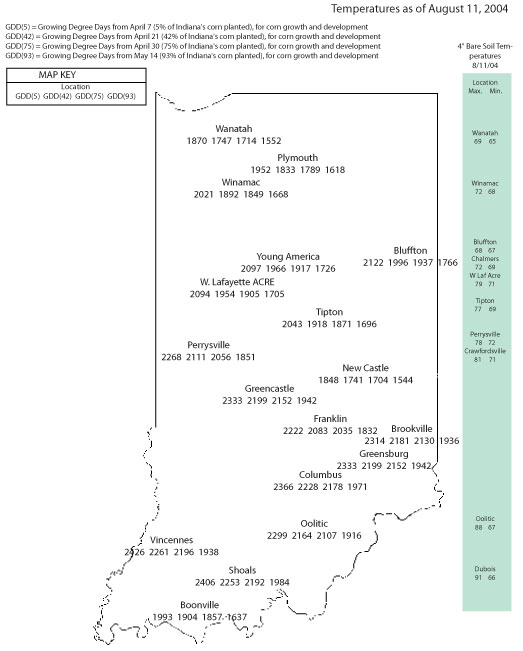Pest & Crop Newsletter
|
|||||||||||||
Some Caterpillars Sting– (John Obermeyer and Larry Bledsoe)
European Corn Borer Moths Remain Low– (John Obermeyer)
Black light trap counts and evening windshield observations have revealed that the second generation corn borer moth flight is low. Don’t count this pest out completely, as there may be some “hot spots” in Indiana. Fields that will be most susceptible to attack are those that are actively pollinating. Consider that replanted areas of fields, that are delayed in development, may be a “trap” crop for these second generation moths. Crops of most economic concern would be seed corn and late market sweet corn.
Click for Table.
|
|||||||||||||
Soybean Sudden Death Syndrome– (Andreas Westphal and Scott T. Abney)
Two weeks ago, we cautioned that high risk for Sudden death syndrome (SDS) was prevalent in Indiana (Pest&Crop No. 20) based on observations in farmers fields and Abney’s and Westphal’s research plots strategically located in southern and central Indiana. At that time, we reported awareness of SDS in highly susceptible varieties. In brief, these conditions include high soil moisture at the beginning reproductive stages and early planting. Currently, foliar symptoms of SDS are most evident across southwest Indiana. When traveling in southern Indiana, we observed large areas with SDS. Symptoms were seen in about half of the fields. Soybeans in fields with SDS are in growth stages R5 to R6 (pod fill), the typical time for the disease to show-up.
Details of the biology of SDS can be found in our previous article. SDS occurs in typical field patterns. Turn rows and wet spots of the affected fields are often first showing premature yellowing of soybean leaves and death of the soybean plants. However, we have also observed fields with an overall healthy plant population, but sprinkled, apparently random plants with SDS symptoms. When inspecting trouble fields, foliar symptoms are a first indication for SDS. Initially, leaves have yellow to brown areas between the major veins. In the progression of SDS, leaflets die and shrivel and drop off, leaving the petioles (leaf stalks) attached. While brown stem rot has similar foliar symptoms, it is distinguished from SDS by symptoms in the plant stem. Brown stem rot darkens the pith but not the cortex. In contrast, the lower stem and taproot of a plant with SDS will exhibit a dark-brown cortex, but white, maybe tan, pith. If a plant with symptoms of SDS is dug from moist soil, there may be small, light-blue patches on the surface of the taproot. So if you suspect SDS in a trouble field you want to dig SDS-suspect plants from the soil, inspect the roots for a blue coating of SDS spores and split the stem. It is likely that this year’s widespread occurrence of SDS in southern Indiana is associated with high soil moisture and the very early planting of soybean. SDS researchers throughout the North Central Region agree that planting early into cool soils increases the risk for this disease. The important predisposing factor: high soil moisture at beginning reproductive stages was also given as rain patterns provided water during the critical stages. We expect a continued spread of SDS symptomatic plants in areas where both predisposing conditions are given. Currently, there is no “quick-fix” remedy for SDS. Yield losses will depend on when (severity and soybean growth stage) SDS fields were infected and what proportion of the plant population was infected. This 2004 SDS awareness should prompt growers to carefully select soybean varieties that have superior ratings relative rating relative to SDS. Large efforts on the management of SDS are afforded throughout the North Central Region, supported by the Indiana Soybean Board, the North Central Soybean Research Program and the United Soybean Board. Emphasis is placed on the development of resistant soybean lines, but also on the basic biology and ecology of the disease. At this time, it is important to make careful note of where the disease occurs (which fields, the pattern of the disease within a field, and symptom severity). In future plantings, the avoidance of extremely early planting, choosing varieties less susceptible to SDS, and any cultural methods that reduce excessive soil moisture, e.g., breaking of compaction layers or improved drainage, has potential to help to manage SDS.
|
|||||||||||||
|
|||||||||||||










